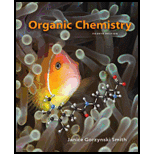
Concept explainers
(a)
Interpretation:
The most stable radical that can result from cleavage of
Concept introduction:
A free radical is an atom or ion with unpaired electrons. They are reactive intermediates formed by the homolysis of covalent bond. Free radicals are classified as
(b)
Interpretation:
The most stable radical that can result from cleavage of
Concept introduction:
A free radical is an atom or ion with unpaired electrons. They are reactive intermediates formed by the homolysis of covalent bond. Free radicals are classified as
(c)
Interpretation:
The most stable radical that can result from cleavage of
Concept introduction:
A free radical is an atom or ion with unpaired electrons. They are reactive intermediates formed by the homolysis of covalent bond. Free radicals are classified as
(d)
Interpretation:
The most stable radical that can result from cleavage of
Concept introduction:
A free radical is an atom or ion with unpaired electrons. They are reactive intermediates formed by the homolysis of covalent bond. Free radicals are classified as
Want to see the full answer?
Check out a sample textbook solution
Chapter 15 Solutions
Organic Chemistry
- Alkyl halides can be reduced to alkanes by a radical reaction with tributyltin hydride, (C4H9)3SnH, in the presence of light (hv). Propose a radical chain mechanism by which the reaction might occur. The initiation step is the light-induced homolytic cleavage of the Sn-H bond to yield a tributyltin radical.arrow_forwardUsing any chemicals you like, make up a free-radical: a) Termination Step: b) Initiation Step: c) Propagation Step:arrow_forwardDefine the Mechanism of the Radical Addition of HBr to an Alkene ?arrow_forward
- PLEASE HELP DRAW THE FREE RADICAL SUBSTITUTION OF CYCLOHEXANE WHICH INOLVES THE 3 STEPS WHICH ARE initiation , propagation and terminationarrow_forwardWhat is the rate expression of •CH4+Cl2 = CCl4+HCI •KClO3=KCl+O2?arrow_forwardThe propagation part of the reaction mechanism involves two steps. Using fishhook arrows to show how the electrons move in these 2 propagation steps. Both of the products are formed in the propagation cycle. The radical consumed in the first propagation step is regenerated in the second propagation step.arrow_forward
- 2,2-dimethylpropane only reacts with bromine in a solvent of CCl4. The presence of sunlight is required in this reaction. Specify the type of reaction and show the complete mechanism for the reaction occurred. This is a free radical halogenation, however I don't understand what it meant by "only recats with bromine in a solvent of CCL4"... can I have some explanation :(arrow_forwardEach step of the propagation portion of the reaction mechanism for free radical chlorination uses _________ and produces __________. a radical; the product a carbocation, a radical a molecule of chlorine; hydrochloric acid a radical; a radical an alkyl halide; an alkyl halidearrow_forwardAutoxidation is described as radical-chain reaction. What is meant by the rem “radical” in this context? By the term “chain”? By the term “chain length”?arrow_forward
 Organic Chemistry: A Guided InquiryChemistryISBN:9780618974122Author:Andrei StraumanisPublisher:Cengage Learning
Organic Chemistry: A Guided InquiryChemistryISBN:9780618974122Author:Andrei StraumanisPublisher:Cengage Learning
 Organic ChemistryChemistryISBN:9781305580350Author:William H. Brown, Brent L. Iverson, Eric Anslyn, Christopher S. FootePublisher:Cengage Learning
Organic ChemistryChemistryISBN:9781305580350Author:William H. Brown, Brent L. Iverson, Eric Anslyn, Christopher S. FootePublisher:Cengage Learning


